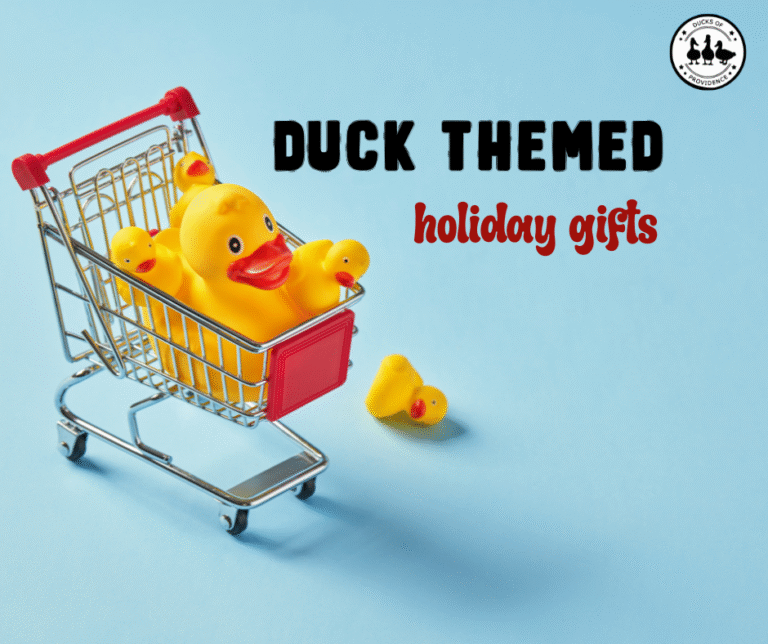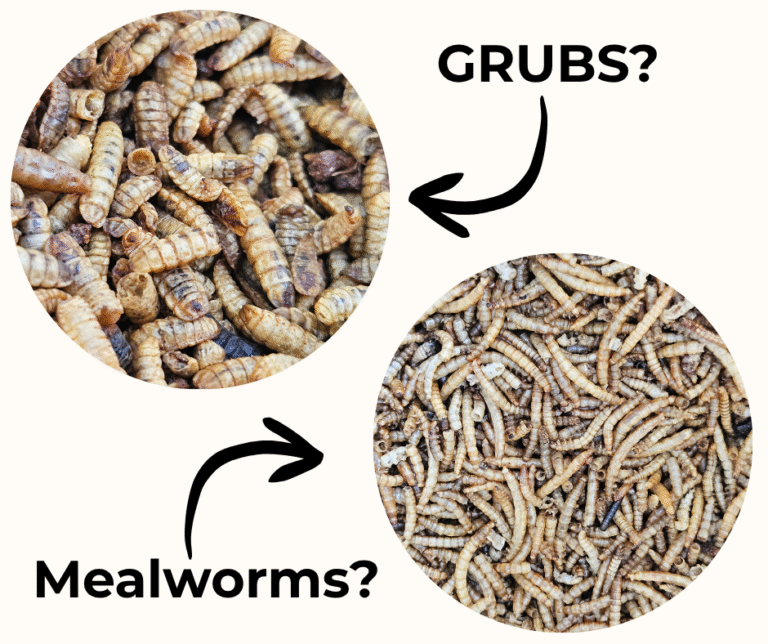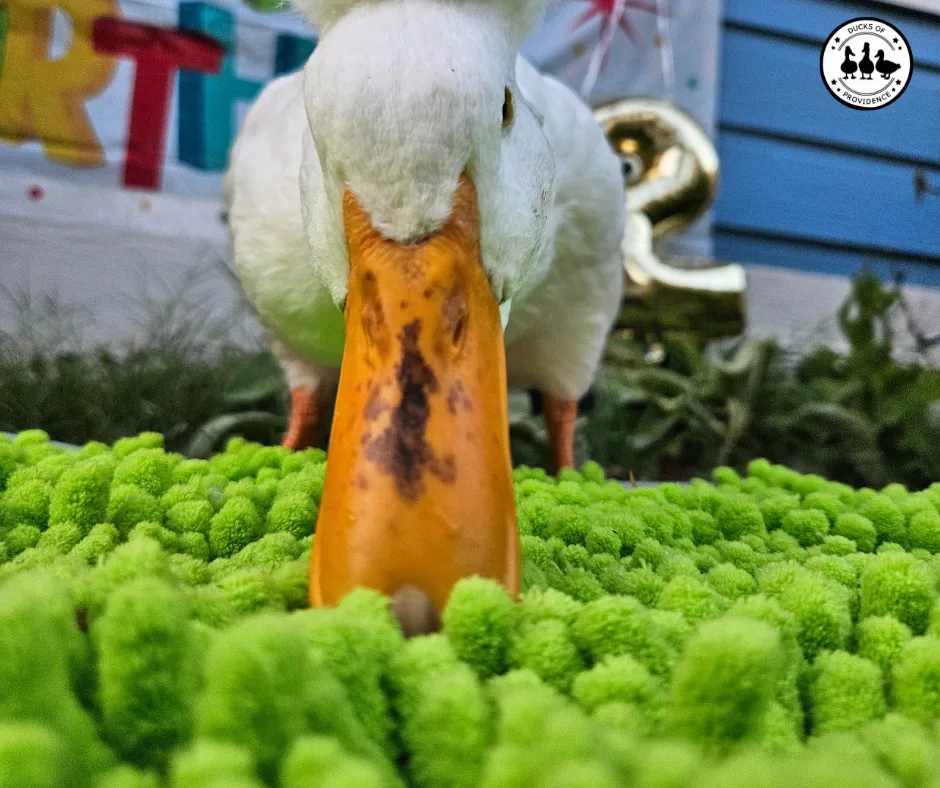
Enrichment and Toys for Ducks
Ducks are naturally curious and intelligent creatures that thrive on exploration and play. Providing toys for ducks is not just a fun addition—it’s essential for their well-being, especially for pet ducks that spend long periods in enclosures for their safety. Engaging toys and enrichment activities help prevent boredom, encourage natural behaviors, and promote mental stimulation. In this guide, we’ll explore the best toys for ducks, from DIY projects to our favorite Amazon picks, to keep your feathered friends happy, healthy, and thoroughly entertained.
Why Enrichment is Important for Ducks
Enrichment is crucial for ducks as it mimics their natural behaviors in the wild. In their natural habitat, ducks spend their time foraging, swimming, exploring, and interacting with their environment. When kept as pets, especially when they are enclosed for safety from predators, it’s essential to replicate these activities to ensure their well-being. Ducks that lack mental and physical stimulation are at risk of boredom, stress, and even behavioral problems.
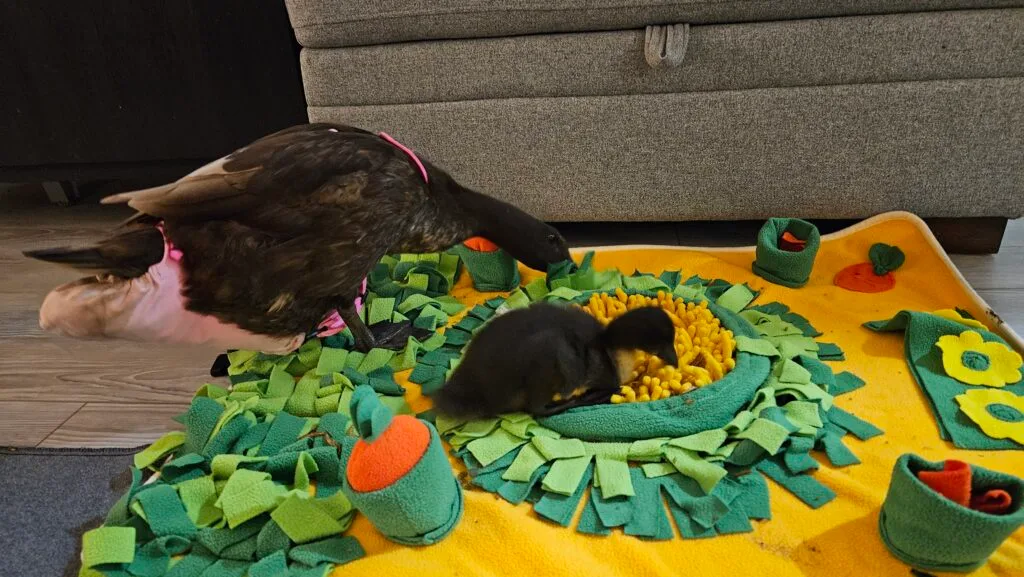
Life in Enclosures: The Need for Stimulation
Pet ducks are often kept in secure enclosures to protect them from predators. While this is necessary for their safety, it can limit their ability to roam, forage, and explore as they naturally would. Without proper enrichment, ducks can become bored, frustrated, and even depressed. This is why providing toys, puzzles, and interactive activities is not just a luxury—it’s a necessity.
Benefits of Enrichment:
- Mental Stimulation: Engaging with toys and puzzles challenges their minds and prevents boredom. Ducks are naturally curious and love to explore their surroundings. By providing different forms of enrichment, you allow them to use their natural instincts in a safe environment.
- Physical Activity: Active play encourages exercise, supporting healthy weight and muscle development. Ducks that spend too much time idle may become overweight or develop health problems related to inactivity.
- Preventing Undesirable Behaviors: Ducks that are bored or unstimulated may develop habits like feather picking, excessive vocalizing, or even aggression. Enrichment helps redirect their energy into positive activities.
- Strengthening Social Bonds: Group activities and shared toys can help strengthen relationships within the flock. When ducks are engaged and happy, they are more likely to interact positively with one another.
- Reducing Stress: Especially during times of confinement, enrichment reduces stress by giving ducks something to focus on and engage with. This is particularly important during flockdown or when you need to keep your ducks inside due to bad weather or predator activity.
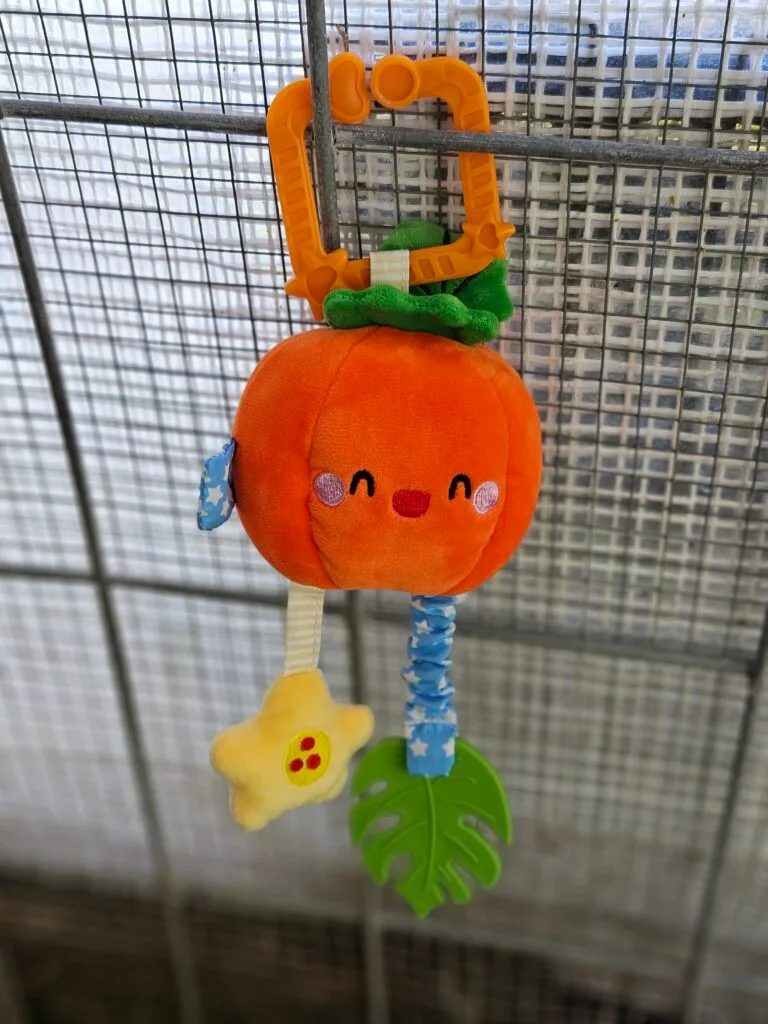
By understanding the importance of enrichment and providing a variety of engaging activities, you can help your ducks lead happier, healthier lives. Whether through DIY projects or some of our favorite toys, mental and physical stimulation makes a tremendous difference in their well-being.
Types of Enrichment and Toys for Ducks
Providing various types of toys for your ducks is essential to keeping them happy, healthy, and mentally stimulated. Here are the main categories of enrichment and how they can benefit your flock:
1. Foraging Enrichment
Foraging is a natural and essential behavior for ducks. In the wild, ducks spend hours each day searching for food—sifting through mud, dabbling in water, and exploring grassy areas. When kept as pets, it’s crucial to replicate this instinctual behavior to keep them mentally and physically stimulated. Foraging enrichment not only combats boredom but also promotes healthy eating habits and exercise.
Benefits of Foraging Enrichment:
- Mental Engagement: Ducks use their natural instincts to seek out food, keeping their minds sharp and active.
- Physical Exercise: Foraging requires ducks to move, search, and sometimes even dig for their treats, supporting muscle development and overall fitness.
- Reduced Boredom: Ducks that have something to search for are less likely to engage in negative behaviors like feather picking.
- Encourages Natural Behaviors: Scattering treats or providing challenging food puzzles helps ducks act like they would in the wild, boosting their overall happiness.
Creative Foraging Ideas:
Treat Balls Filled with Mealworms or Grubs
These toys are designed to be pushed around, releasing treats like mealworms or grubs as they roll. The movement keeps ducks interested, and the reward system encourages continued play. You can even make your own treat balls using a small wiffle ball—just fill it with treats and watch your ducks go crazy for it!
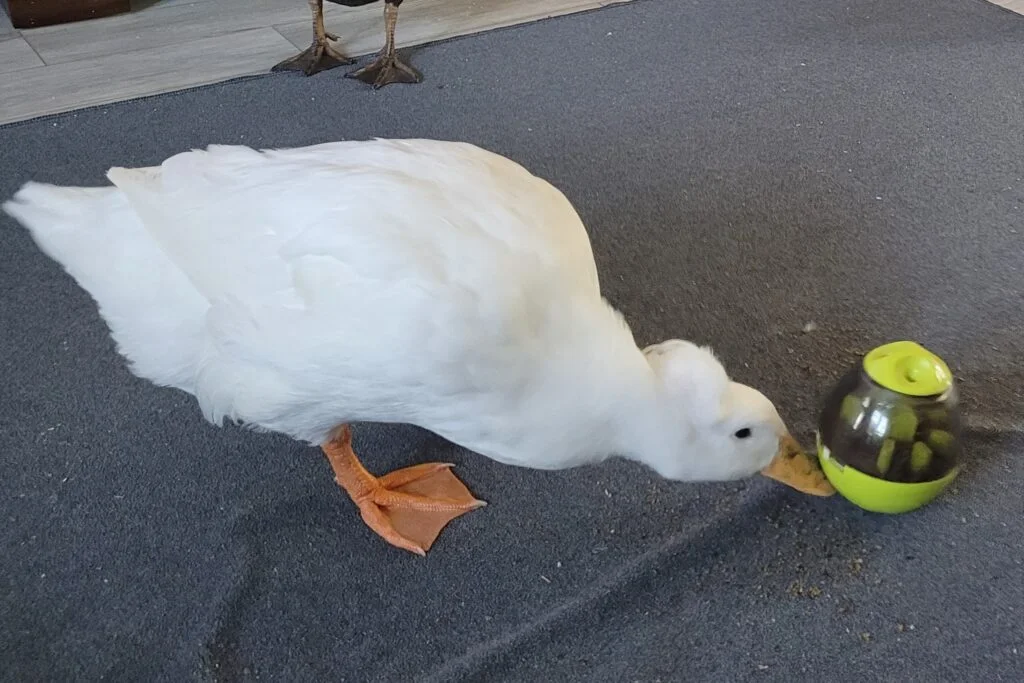
Hanging Lettuce or Kale from String
Suspend leafy greens from a string just above their reach. Ducks will jump, stretch, and peck at the dangling greens, turning feeding time into a playful challenge. You can hang the string from the roof of their run or a low tree branch, making sure it’s secure and within a safe height.
Scattering Mealworms or Small Treats in the Grass
This is one of the simplest and most natural ways to encourage foraging. Sprinkle mealworms, cracked corn, or even chopped vegetables throughout their enclosure. Your ducks will eagerly search the grass and dirt, mimicking the foraging they would do in the wild. For an added challenge, toss the treats into a pile of straw or leaves to make them work a little harder.
Snuffle Mats
Originally designed for dogs, snuffle mats are perfect for ducks! These mats are made of soft fabric strips where you can hide small treats like peas, corn, or mealworms. Ducks will enjoy rooting around to find each morsel, engaging their natural foraging instincts. You can even make your own by cutting fleece strips and tying them through a rubber mat.
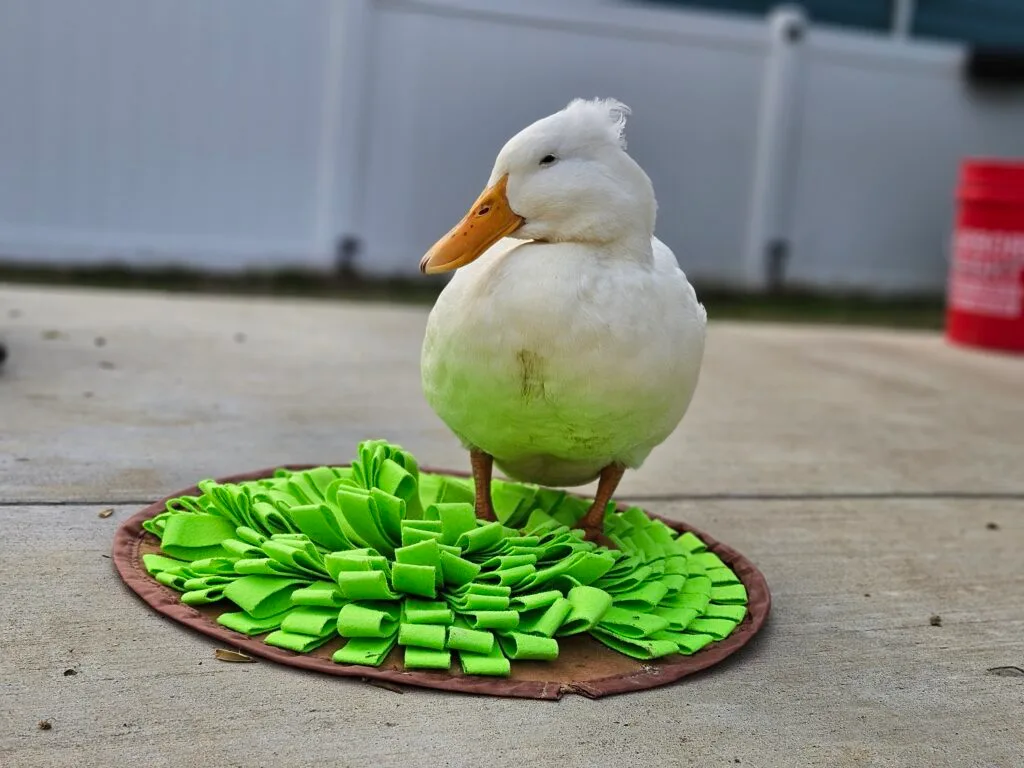
DIY Foraging Boxes
Fill a shallow box with hay, straw, or pine shavings and hide small treats inside. Ducks will happily dig through the material to find their rewards, mimicking the rooting behavior they naturally display in the wild. Make sure the materials are safe and non-toxic.
Peck-and-Find Bottle Feeder
Take an empty plastic water bottle, punch a few small holes in it, and fill it with dried mealworms or cracked corn. When your ducks peck or nudge the bottle, the treats fall out. This simple DIY toy encourages them to work for their food, providing both physical activity and mental stimulation.
Treasure Hunt with Fresh Greens
Hide small bundles of fresh greens (like tomatoes or dandelion leaves) around their enclosure. Tuck them behind logs, under overturned flower pots, or between rocks. Your ducks will wander around, searching out each delicious surprise.
Safety Tips:
- Always use non-toxic materials for any DIY projects.
- Supervise new foraging toys to ensure your ducks are interacting safely.
- Regularly inspect for wear and tear, especially with plastic items, to prevent ingestion of small bits.
- Rotate the enrichment activities to keep them fresh and exciting—ducks are smart, and they love variety!
2. Water-Based Enrichment
Ducks are waterfowl by nature, and water is not just a place for them to drink—it’s their playground. In the wild, ducks spend a lot of time swimming, dabbling, and foraging in water. Mimicking these activities in a domestic setting helps keep them happy, clean, and mentally stimulated. Providing access to water-based enrichment allows them to express natural behaviors like preening, foraging for food, and socializing.
Benefits of Water-Based Enrichment:
- Encourages Natural Behavior: Swimming, dabbling, and diving are instinctual activities for ducks, and water access lets them perform these behaviors naturally.
- Physical Exercise: Splashing and swimming are great ways for ducks to build muscle tone and stay fit.
- Promotes Preening and Feather Health: Ducks need water to maintain their feathers. Water play encourages preening, which helps keep their feathers waterproof and in good condition.
- Reduces Stress: Access to water gives ducks a sense of comfort and security, reducing stress and preventing boredom.
- Social Engagement: Ducks love to swim together, reinforcing their social bonds and reducing aggressive behaviors.
Creative Water-Based Enrichment Ideas:
Floating Toys
Ducks love chasing things that move in the water. Small floating balls, rubber ducks, and even floating treat dispensers can encourage playful swimming and interaction.
- Try adding floating balls of different colors to see which ones your ducks like best.
- For extra fun, you can stuff rubber ducks with peas or mealworms, making it a floating foraging game.
Sprinklers or Misters
Ducks naturally love splashing around in water, and sprinklers or misters provide the perfect opportunity for play.
- Set up a gentle sprinkler in their enclosure on hot days. Ducks will dance and flap in the spray, cooling off and enjoying the mist.
- A mister placed at duck height can provide fine droplets that your ducks can waddle through and preen under.
- Make sure the water pressure is low to avoid scaring them—gentle rain-like mist is ideal.
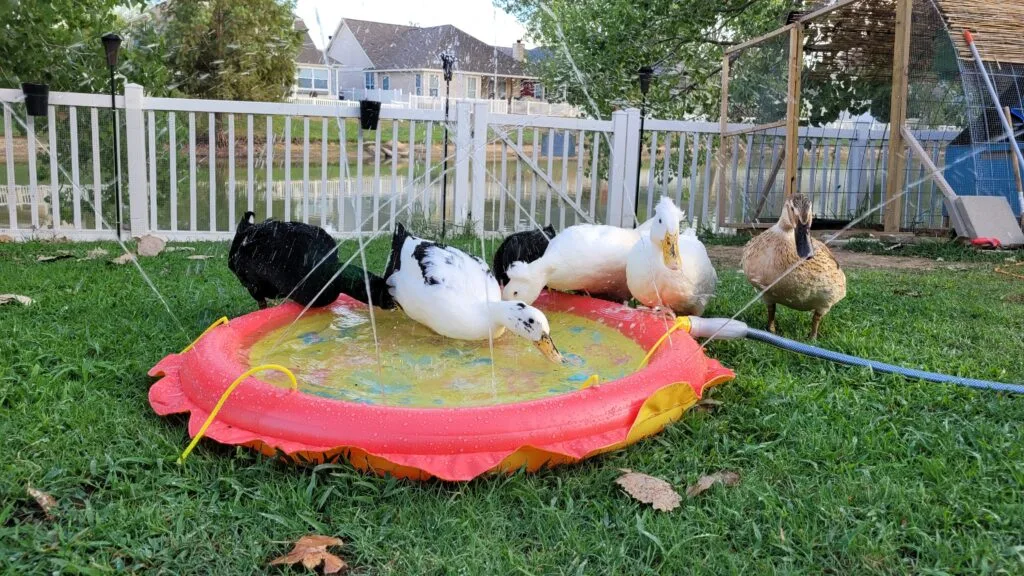
Splash Pads
These are fantastic options for safe, shallow water play. Splash pads are often made for children, but ducks adore the tiny water fountains and shallow puddles.
- Choose one with soft material and non-slip surfaces for duck safety.
- You can connect it to a standard garden hose, and it will spray gentle fountains that your ducks will love waddling through.
Kiddie Pools with Floating Greens or Peas
A simple kiddie pool can become an exciting play area for your ducks. Fill it with fresh water and toss in some floating greens or peas.
- Peas, corn, and chopped lettuce are great choices—they float and encourage dabbling.
- You can even add a small layer of dirt or mud at the bottom to mimic natural pond conditions, allowing your ducks to forage and dig around.
- Make sure to refresh the water regularly to keep it clean and safe.
DIY Duck Pond with a Drainage System
If you’re looking for a long-term solution, consider setting up a small DIY duck pond with a built-in drainage system for easy cleaning.
- You can add floating plants like water hyacinth or duckweed to encourage natural foraging.
- For added fun, introduce floating platforms or mini duck rafts that they can climb on and jump off.
Waterfall Feature or Bubbling Fountain
Adding a small water feature like a gentle waterfall or bubbling fountain to your duck’s water play area can provide both enrichment and visual appeal.
- Ducks love exploring the movement of water and will often dip their heads under a gentle waterfall.
- Make sure it’s duck-friendly with smooth surfaces and shallow depths.
DIY Water Maze
Create a simple water maze using floating pool noodles or small barriers in a kiddie pool. Ducks will happily explore, pushing their way through and splashing around.
Safety Tips:
- Always supervise your ducks during water play, especially if using deeper water.
- Clean water sources frequently to prevent algae and bacteria buildup.
- Make sure any water feature has a shallow exit so ducks can easily get out.
- Avoid adding chlorine or other chemicals; ducks are sensitive to water additives.
3. Interactive Puzzles
Ducks are surprisingly intelligent and can benefit from interactive toys that challenge their problem-solving skills. These types of enrichment can prevent boredom and keep their minds sharp.
Examples:
- Puzzle Feeders: These feeders require ducks to figure out how to get their food out, encouraging mental engagement.
- DIY Cardboard Mazes with Hidden Treats: Simple cardboard structures with small food rewards hidden inside make for great exploratory fun.
- Treat Dispenser Toys – These are designed to release treats as ducks peck or nudge them around.
4. Sensory Enrichment
Stimulating a duck’s senses is another fantastic way to keep them engaged. Ducks are very responsive to visual and auditory cues, and sensory enrichment can tap into that.
Examples:
- Mirrors for Visual Engagement: Ducks are naturally curious about reflections, and mirrors can keep them occupied.
- Bells and Gentle Wind Chimes for Auditory Stimulation: Soft noises provide something new for them to explore.
- Mirrors with Bells – Combines visual and auditory enrichment for double the fun.
5. Companion-Based Enrichment
Ducks are social creatures that thrive with companionship, whether with other ducks or their human caretakers.
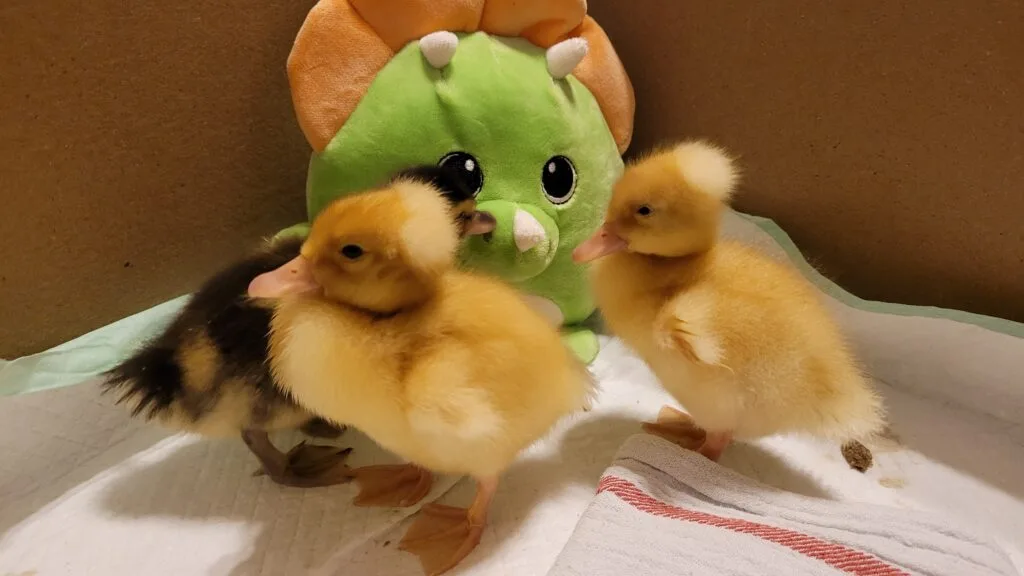
Examples:
- Time Spent with You or Other Ducks: Regular interaction helps ducks feel secure and loved.
- Supervised Exploration Outside of Their Run: Ducks love exploring new areas, and a change of scenery can be incredibly stimulating.
- Plush Duck Toys – For comfort and snuggling, especially if a duck is separated from its companions.
Each of these enrichment types not only entertains but also promotes healthy physical and mental well-being for your ducks. In the next section, we will explore some creative DIY options that you can easily make at home to keep your ducks engaged and happy.
DIY Duck Toys
Making your own duck toys can be a fun, cost-effective way to provide enrichment for your feathered friends. Ducks are naturally curious and playful, and simple DIY projects can bring hours of entertainment while also encouraging natural behaviors like foraging, pecking, and exploring. Best of all, many of these projects can be created using materials you likely already have at home!
Benefits of DIY Duck Toys:
- Cost-Effective: You can use recycled or inexpensive materials to create engaging toys.
- Customizable: You can easily adjust the design to suit your duck’s preferences.
- Encourages Natural Behaviors: Foraging, pecking, and exploring are instinctual for ducks, and DIY toys help mimic these activities.
- Bonding Opportunity: Crafting toys for your ducks provides a chance to observe their behavior and learn what they enjoy most.
Creative DIY Duck Toy Ideas:
- Pea Rattle Bottle
This simple toy encourages both foraging and movement.
Materials Needed:- Empty plastic water bottle
- A handful of dried peas or corn
- Optional: a few small pebbles for added noise
- Fill the empty bottle with dried peas or corn. You can also add a couple of small pebbles to make it more interesting.
- Seal the bottle tightly (if you want extra security, tape the cap to prevent accidental opening).
- Place it in their run and watch them roll it around with their bills and feet, entertained by the rattling sound and the promise of food.
- Treat Hanging String
Perfect for encouraging natural pecking and reaching behaviors.
Materials Needed:- Strong string or twine
- Leafy greens (lettuce, kale, spinach) or whole vegetables (corn on the cob, cucumber)
- Tie the greens or vegetables securely to the string.
- Hang it from the top of the run or a tree branch, just high enough that ducks have to stretch to reach it.
- This setup mimics foraging from low-hanging plants and keeps them entertained for hours.
- Cardboard Box Tunnels
Ducks are naturally curious and love exploring small spaces. Cardboard tunnels are a simple and fun way to give them a sense of adventure.
Materials Needed:- Large cardboard boxes
- Scissors
- Duct tape
- Cut out openings on each end of the cardboard box to create a tunnel.
- Tape multiple boxes together to create a longer tunnel system, or even a small maze.
- Place it in their run and watch them waddle through, exploring every nook and cranny.
- Egg Carton Forager
A creative way to encourage foraging and problem-solving.
Materials Needed:- Empty cardboard egg carton
- Peas, mealworms, or small treats
- Place small treats in the individual egg slots.
- Close the carton but don’t seal it completely—just enough to make them work a little.
- Scatter it in their play area and watch them figure out how to get to the treats.
- Duck Piñata
A playful way to distribute treats and encourage pecking.
Materials Needed:- Small paper bagStrawPeas, mealworms, or cracked cornString
- Fill the paper bag with shredded paper or straw and add some treats.Tie it securely with string and hang it from a sturdy branch or the roof of their run.Ducks will peck and tug at the bag until it breaks, releasing their hidden snacks.
- DIY Pea Dispenser Tubes
A super simple, yet entertaining game for ducks.
Materials Needed:- PVC pipe (about 12–18 inches long)
- End caps
- Peas or mealworms
- Drill a few small holes along the length of the PVC pipe—just big enough for peas to fall through.
- Cap one end of the pipe, fill it with peas, and cap the other end.
- Place it on the ground and watch your ducks roll, nudge, and peck it to get their rewards.
Safety Tips for DIY Toys:
- Always use non-toxic materials—avoid painted or chemically treated wood, and ensure plastics are food-grade.
- Check regularly for wear and tear; replace or repair damaged toys to prevent injuries.
- Avoid string or twine that could become tangled around their legs or neck.
- Supervise new toys until you’re sure they are safe and suitable for your ducks.
Safety Considerations
When selecting toys or designing enrichment activities for your ducks, always consider their safety:
- Avoid small parts that can be swallowed.
- Ensure materials are non-toxic and durable.
- Regularly inspect toys for wear and tear to prevent injuries.

Final Thoughts
Providing toys and enrichment for your ducks is a rewarding way to keep them happy and healthy. Not only does it prevent boredom, but it also encourages natural behaviors and strengthens the bond between you and your flock. Whether you go the DIY route or choose one of our favorite products, your ducks will appreciate the extra stimulation. With a little creativity, you can turn your duck’s environment into a playground that brings endless joy and fun.














